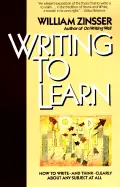
Writing to Learn - by William Zinsser
ISBN: 0062720406Date read: 2021-09-04
How strongly I recommend it: 3/10
(See my list of 430+ books, for more.)
Go to the Amazon page for details and reviews.
Part memoir, part writing instruction, but mostly just examples of good writing from different disciplines. The point is that writing well about a subject helps you learn it, and reading great writing about a subject makes a huge difference. But too much of the book were just examples that I didn’t find useful for my needs.
my notes
Writing is primarily an exercise in logic.
Begin with imitation.
Read writers who were doing the kind of writing you want to do.
Try to figure out how they did it.
After a lifetime of writing I still revise every sentence many times and still worry that I haven’t caught every ambiguity.
I don’t want anyone to have to read a sentence of mine twice to find out what it means.
There is no typical anybody; every reader is different.
Edit for yourself and write for yourself.
Assume that if you consider something interesting or funny, a certain number of other people will too.
The best minds in other disciplines would talk about how rhythm is at work in what they do.
Symmetry and dissymmetry in molecular structure.
Numerical repetition in the formation of crystals.
Rhythmic movement of lake waters.
Rhythm in painting.
The reader should be given only as much information as he needs and not one word more.
Anything else is a self-indulgence.
Readers must be given room to bring their own emotions to a piece so crammed with emotional content.
The writer must tenaciously resist explaining why the material is so moving.
An idea can have value in itself, but its usefulness diminishes to the extent that you can’t articulate it to someone else.
A great paper in philosophy tells me why the student couldn’t get where he wanted to go.
Failure is often the beginning of wisdom.
Teacher assigned students a paper that would be read aloud in class. It gets them to write for their peers and not for the teacher.
In a poor paper, there’s not much in it to discuss - no place to start.
Two kinds of writing:
Explanatory writing: writing that transmits existing information or ideas.
Exploratory writing: writing that enables us to discover what we want to say.
Explanatory writing:
Think!
What do I want to say?
Then try to say it.
Have I said it?
Put yourself in the reader’s mind:
Is your sentence absolutely clear to someone who knows nothing about the subject?
If not, think about how to make it clear. Then rewrite it.
Then think:
What do I need to say next?
Will it lead logically out of what I’ve just written?
Will it also lead logically toward where I want to go?
If it will, write the sentence.
Did it do the job I wanted it to do, with no ambiguity?
If it did, think: Now what does the reader need to know?
Keep thinking and writing and rewriting.
If you force yourself to think clearly you will write clearly. It’s as simple as that.
The hard part isn’t the writing; the hard part is the thinking.
Exploratory writing is not a license to let it all hang out.
However subconsciously they may stumble on what they want to say, they are finally as obligated as every other writer to make themselves understood.
A simple style is the result of harder thinking and harder work.
People who write obscurely are either unskilled in writing or up to mischief.
Active verbs are a writer’s best friend.
Show and tell.
The writer should not only tell a story; he should try to make the reader see what he is writing about.
We wish the writer had had a better time - or at least had given us that impression.
The reader has to believe that the writer is feeling good.
When I wrote my book “On Writing Well” I had a definite model in mind: Alec Wilder’s American Popular Song,